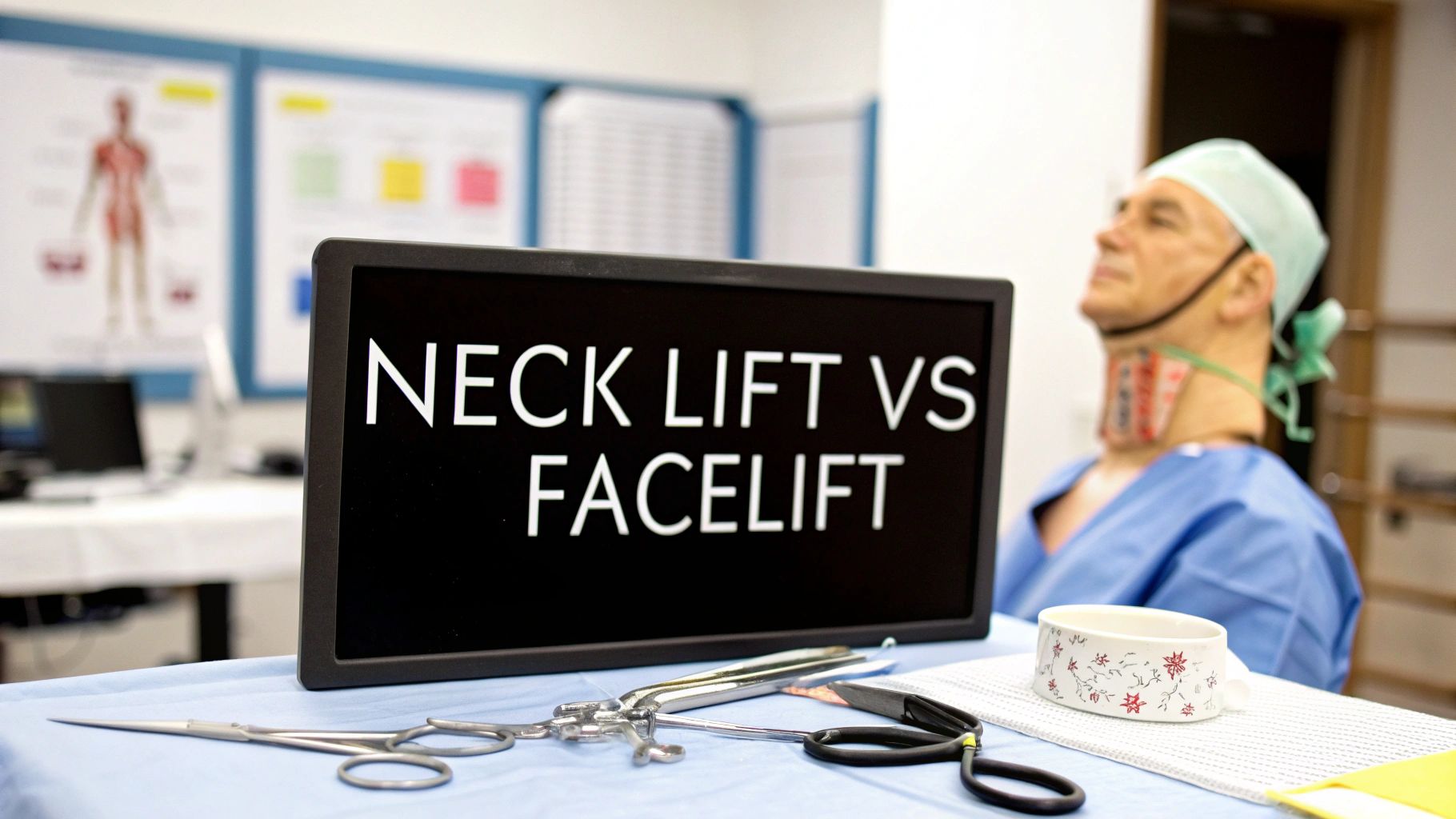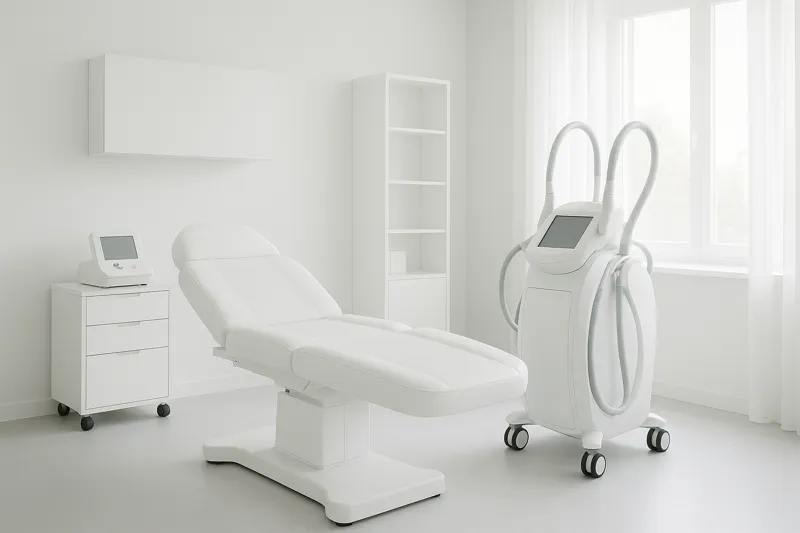
December 25, 2025
How to Make My Neck Thinner: A Practical Guide
Learn how to make my neck thinner with practical exercises, non-surgical options, and tips for a defined jawline.
Nov 8, 2025

When you're trying to decide between a neck lift vs a facelift, the core difference really comes down to this: a facelift addresses the mid-to-lower face, like sagging cheeks and jowls, while a neck lift zeroes in on the neck and jawline. The right choice for you hinges on which area is showing the most noticeable signs of aging.
It’s easy to think of these two procedures as one and the same, but they are designed to solve very different aesthetic concerns. A facelift is all about restoring youthful contours to the face itself—from the cheeks right down to the jaw. A neck lift, on the other hand, is entirely focused on refining and sculpting the area below your chin.
Think about it in terms of anatomy. A facelift and neck lift are separate cosmetic surgeries, each tackling different parts of your profile and delivering unique results. Facelifts are the go-to for the mid and lower face, dealing with sagging cheeks, the formation of jowls, and those deep nasolabial folds. A neck lift, however, is specifically for the neck and jawline, correcting loose skin, vertical muscle bands (that dreaded 'turkey neck'), and extra fat under the chin.
Getting clear on the specific goals of each surgery is the best way to figure out which one might be right for you. While both aim to give you a more refreshed, youthful look, how they get there—and the areas they target—are completely different.
Facelift: This procedure is focused on lifting and tightening the underlying facial muscles (what we call the SMAS layer) and trimming away excess skin. The goal is to correct jowls and soften deep wrinkles around the mouth for a smoother, firmer facial structure.
Neck Lift: Here, the surgeon works to remove sagging skin (a 'cervicoplasty'), tighten those prominent vertical neck bands (a 'platysmaplasty'), and often uses liposuction to get rid of excess fat.
It's also important to remember that surgery isn't the only path, especially for those with earlier signs of aging. If you're looking into less invasive options, you can learn more about non-invasive skin tightening in our detailed guide. It can be a great alternative or even a complementary treatment.
The simplest way I explain it to my patients is this: a facelift restores the frame of your face, while a neck lift sharpens the silhouette of your profile. One deals with facial volume and sagging; the other sculpts the jawline and neck.
Sometimes, seeing things side-by-side makes the decision clearer. This table breaks down the essential differences between a facelift and a neck lift at a quick glance.
Ultimately, this table highlights that while both procedures offer rejuvenation, their purpose and ideal candidate are quite distinct. Your surgeon will help you determine which approach aligns best with your personal aesthetic goals.
When deciding between a neck lift and a facelift, your age is far less important than your specific anatomy. The real key to a great result is matching the right surgical technique to your unique signs of aging. Honestly, the only way to know for sure is to sit down with a board-certified plastic surgeon for a proper consultation.
They'll take a close look at everything—your skin's elasticity, how much jowling you have, any volume loss in your cheeks, and the condition of the muscles in your neck. This detailed assessment helps figure out if your concerns are just in one spot or if a combined approach would give you a more balanced, natural look.
Someone who's a great fit for a facelift usually shows signs of aging across the mid-to-lower face and jawline. Their concerns aren't just about the neck; they see changes creeping up into their cheeks and along the jaw.
You might be a perfect facelift candidate if you're dealing with:
On the flip side, the best candidate for a neck lift is someone whose aging is almost exclusively below the chin. Their face might still look firm and youthful, but their neck is telling a different story. Many people start looking into procedures when addressing sagging neck and jowls, but it's crucial to understand a neck lift is a very targeted surgery.
A strong candidate for a neck lift on its own usually has:
This decision tree gives you a quick visual on how to think about the primary concerns.

As you can see, it really boils down to where your main issues are. If they're on your face, you're leaning toward a facelift. If they're isolated to your neck, a neck lift is likely the right path.
Let’s put this into practice with a couple of common examples.
Scenario A: The Facelift Candidate
Picture a 62-year-old woman who feels she constantly looks tired or sad. She has deep smile lines, very noticeable jowls that have erased her jawline, and a general droopiness in her cheeks. Her neck has some laxity too, but her main frustration is with the heavy, sagging look of her lower face. She is a textbook candidate for a facelift, as it will address all these interconnected areas for a cohesive, refreshed appearance.
Scenario B: The Neck Lift Candidate
Now, think about a 55-year-old man who has kept good volume in his face and has minimal jowling. His problem is a prominent double chin and those vertical bands on his neck that make him look much older than he feels. For him, a standalone neck lift is the perfect fix. It will sharpen his profile and smooth his neck without changing his face at all.
A crucial insight from surgeons is that trying to fix significant jowls with only a neck lift often creates an unnatural, 'pulled' look. A facelift is really needed to properly redrape the facial skin that's causing the jowls in the first place.
At the end of the day, understanding these profiles helps you go into a consultation with realistic expectations. Your surgeon’s final recommendation will come from a hands-on examination and a real conversation about your goals, making sure you get the procedure that will truly work best for you.

To really understand the difference between a facelift and a neck lift, you have to look at what's happening under the skin. While both procedures are designed to turn back the clock, the surgical approaches are fundamentally different because they target unique anatomical areas. The real distinction comes down to the depth and direction of the surgeon's work.
A modern facelift isn't just about pulling skin tight. That's an outdated approach that leads to that "windswept" look everyone wants to avoid. Instead, today's techniques are all about repositioning the deeper, foundational structures of the face to create a result that's both natural and long-lasting.
The secret to a great facelift lies in working with the Superficial Musculoaponeurotic System (SMAS). Think of the SMAS as a fibrous web deep beneath the skin that connects and supports your facial muscles. By addressing this deeper layer, a surgeon can lift and redefine the face from the inside out.
Surgeons typically use one of two main approaches:
SMAS Lift: Here, the surgeon makes discreet incisions, usually hidden along the hairline and in the natural creases around the ear. They then gently lift the skin to get to the SMAS layer. The SMAS is then tightened and anchored into a more youthful position before the skin is laid back down, and the excess is removed. It's an incredibly effective method for correcting jowls and softening deep facial folds.
Deep Plane Facelift: This is a more advanced technique for more significant aging. Instead of separating the skin and SMAS, the surgeon lifts them together as one unit. By releasing certain ligaments, this approach allows for a more powerful, tension-free lift of the mid-face, which dramatically improves the cheeks and jawline. The results are often exceptionally natural and durable.
The best technique for you really depends on your facial anatomy and what you're hoping to achieve. A deep plane lift can deliver a more profound change for those with considerable sagging. To get a better sense of these procedures, our in-depth guide on facelift surgery techniques and recovery provides a lot more detail.
When the neck is the main area of concern, the surgery is more focused but no less complex. The goal of a neck lift (or lower rhytidectomy) is to bring back that sharp, elegant angle of the jawline and create a smooth contour from chin to collarbone. It's a three-pronged attack on skin, fat, and muscle.
A neck lift typically involves a combination of these steps:
The decision to perform a platysmaplasty is a critical differentiator. While liposuction can remove fat, only tightening the platysma muscles can truly eliminate those prominent vertical bands that are a tell-tale sign of an aging neck.
When you compare a neck lift vs a facelift, the techniques show you exactly what each is designed to do. A facelift is about comprehensively repositioning the entire facial structure, while a neck lift is about skillfully sculpting the jawline and neck. Often, the best results come from combining them, ensuring a seamless, harmonious rejuvenation from top to bottom.

Getting a handle on the recovery process is one of the most important parts of planning for surgery. When you’re weighing a neck lift against a facelift, the downtime is a huge consideration—it affects your work, your social life, and everything in between. While everyone heals at their own pace, we have a pretty good idea of the timelines and milestones for each procedure.
The main difference really comes down to the scale of the surgery. Facelifts are more complex and involve more extensive work, so the recovery naturally takes a bit longer, usually requiring at least two weeks of downtime. A neck lift, being more focused, often has a slightly shorter recovery, typically falling in the one-to-two-week range.
Those first 7 to 10 days are definitely the most intense part of healing for either procedure. You should expect a good deal of swelling, bruising, and a noticeable feeling of tightness where the work was done. A facelift usually brings more pronounced swelling and bruising that can spread up into the cheeks and even around the eyes.
For both surgeries, your surgeon will send you home with a compression garment or special dressings. These are absolutely essential—they help keep swelling down and give your healing tissues the support they need. Pain is generally well-managed with the medication your doctor prescribes. The best thing you can do for yourself during this time is simply rest and let your body do its work.
It's also important to manage any general soreness you might feel. For those looking for complementary, non-medical options, exploring strategies for natural neck pain relief can sometimes help with overall comfort.
This is when you’ll really start to feel and look more like yourself again. For many people who had a neck lift, the second week is a big milestone. They often feel comfortable enough to go back to a desk job and resume light daily tasks, although hitting the gym is still a no-go.
Facelift patients might find they need a little more time. It's common for some residual swelling and bruising to hang around into the third week. While you might feel fine, the visible signs of surgery are often still there, leading many patients in public-facing roles to take a full three weeks off.
A piece of advice I always give my patients: "Don't judge your results in the first month. Swelling can hide the final contours, and what you see in the mirror at two weeks is not the finished product." Having a little patience is key to managing your own expectations.
By the end of week three, most people are feeling significantly better. To learn more about how to make your own recovery go as smoothly as possible, take a look at our guide on https://www.ccplasticsurgery.com/blog/essential-recovery-tips-after-plastic-surgery.
Once you hit the one-month mark, the recovery differences between a facelift and a standalone neck lift start to blur. The vast majority of the swelling and bruising has gone down, giving you a much clearer glimpse of your new look.
Here's a general roadmap for what to expect as you continue to heal:
To help you visualize the time commitment for each procedure, this table breaks down the key recovery milestones side-by-side.
At the end of the day, a facelift just requires a bit more social downtime because of the more extensive work on the face. Since a neck lift is more localized, it usually lets you get back to your routine a little faster.

Let's get to the most exciting part: what will you actually look like after the surgery? While both a neck lift and a facelift promise a younger-looking you, the specific changes they create are very different. The best procedure is the one that delivers a final look directly targeting your main concerns, whether that’s sagging in your face or a jawline that’s lost its edge.
A facelift is all about bringing back that classic "V-shape" we associate with a youthful face. The surgeon goes deeper than just the skin, lifting and repositioning the underlying facial tissues. This is what elevates sagging cheeks, softens deep marionette lines, and—most crucially—gets rid of jowls. The final result should be a refreshed, more vibrant appearance, not a pulled or obviously "done" look.
A neck lift, on the other hand, zeroes in on creating a sharp, elegant profile from your jaw down to your collarbone. The entire aesthetic is built around contour and definition. By trimming away excess skin, tightening the neck muscles, and sculpting away stubborn fat, a neck lift gives you back a crisp jawline and a smooth, firm neck.
A skillfully performed facelift provides a comprehensive refresh of the lower two-thirds of the face. It’s common for patients to tell me that friends just say they look "well-rested" or "like they had a great vacation"—not that they suspect surgery. The whole point is to turn back the clock, not to change who you are.
Here are the key aesthetic improvements you can anticipate:
The most beautiful facelift results are all about harmony. It’s not about fixing one thing in isolation; it's about how lifting the cheeks and jawline work together to restore the face's natural, youthful architecture.
The power of a neck lift is often most obvious when you see the results in profile. This procedure is the gold standard for fixing issues that are concentrated below the chin, creating a dramatic improvement in your silhouette without touching your facial features.
The main aesthetic changes from a neck lift include:
This is one of the first questions everyone asks, and it's a critical one. While no cosmetic surgery can stop you from aging, both of these procedures offer impressively long-lasting results. A facelift can make you look 10 to 15 years younger, and you can generally expect those effects to last for about 10 years. A neck lift is just as durable, effectively restoring the jawline and neck contour for a similar amount of time. You can find more expert takes on the longevity of facial procedures on austinface.com.
Of course, the lifespan of your results depends heavily on you. Lifestyle choices make a huge difference—things like sun exposure, smoking, and major weight changes can speed up aging and undo some of the work. Your genetics and skin quality also play a role in how gracefully you age after surgery. Down the road, many patients choose to maintain their look with non-surgical treatments like dermal fillers or laser resurfacing to keep their results looking fresh for as long as possible.
https://www.youtube.com/embed/9v7ekxSU3Gw
The whole neck lift vs. facelift debate often ends with a simple realization: why not both? For a lot of people, the signs of aging aren't just isolated to one spot. They create a continuous line from the face down to the neck, making it a single aesthetic problem.
This is especially true when you see significant sagging in both areas. Someone might have prominent jowls that soften the jawline, which then flows right into a loose, wrinkled neck. If you only fix one of these areas, the result can look mismatched and unnatural.
The main reason to combine these procedures is to create a smooth, seamless transition from your cheeks all the way down to your collarbone. Imagine getting a facelift while leaving a very loose neck untouched—the neck’s age would suddenly look even more obvious. The reverse is just as true.
Combining the surgeries offers several powerful advantages:
The most natural results come from treating the face and neck as one aesthetic unit. When jowling and neck laxity are present together, a combined approach is often the only way to restore a truly youthful and balanced profile.
Many patients instinctively get this. They choose a combined facelift and neck lift to get a complete refresh of their lower face and neck, especially when both areas have been equally affected by aging. You can read more expert opinions on facial procedures at austinface.com.
At the end of the day, if your concerns include both facial jowling and visible neck aging, a combined procedure will almost certainly give you the most satisfying and cohesive outcome. It creates a refreshed look that appears completely natural, not "done."
Deciding between a neck lift and a facelift brings up a lot of questions. It's completely normal to want to get into the details before making a choice. Let's walk through some of the most common concerns I hear from patients, from scarring to non-surgical options, to give you the clarity you need.
This is probably the number one question on everyone's mind, and for good reason. A good surgeon is not just a technician but an artist, and that includes hiding the evidence.
With a facelift, I place incisions very carefully along the natural contours of your face. They typically run in the crease right in front of the ear, curve around the earlobe, and then extend up behind the ear into the hairline. Once healed, they blend right in and become remarkably difficult to spot.
For a neck lift, there's often a small incision tucked away in the crease right under your chin. This gives me direct access to tighten the underlying muscles. This is usually paired with incisions behind the ears, much like those in a facelift, to remove any loose skin.
The world of non-surgical treatments is exciting, but it's important to have realistic expectations. Things like radiofrequency or ultrasound can definitely improve skin texture and provide a bit of tightening for mild laxity. They're great for younger patients who are just starting to see changes or for maintaining surgical results.
However, these treatments only work on the skin's surface. They can't lift and reposition the deeper layers of muscle and tissue (the SMAS layer) that are responsible for significant sagging, jowls, or prominent neck bands.
Think of it this way: non-surgical options are fantastic for skin quality and minor touch-ups. But if you're dealing with structural issues like heavy jowls or a "turkey neck," surgery is still the most effective way to get a truly significant and lasting correction.
Your consultation is your time to get all the answers you need to feel completely comfortable and confident. It’s a two-way conversation. To get the most out of it, I always suggest patients come in with their questions written down.
Here are a few great starting points to guide your discussion:
Being an active, informed participant in this process is the best way to ensure you and your surgeon are on the same page and that you'll be thrilled with the outcome.
Ready to explore your options with an expert? At Cape Cod Plastic Surgery, Dr. Fater provides personalized consultations to help you understand which procedure will best achieve your aesthetic goals. Schedule your appointment today to create a plan that’s right for you.

December 25, 2025
Learn how to make my neck thinner with practical exercises, non-surgical options, and tips for a defined jawline.

December 25, 2025
Your Essential Guide to Successful Post-Surgery Recovery

December 25, 2025
Unlock a New Level of Confidence: 5 Key Benefits of Body Contouring